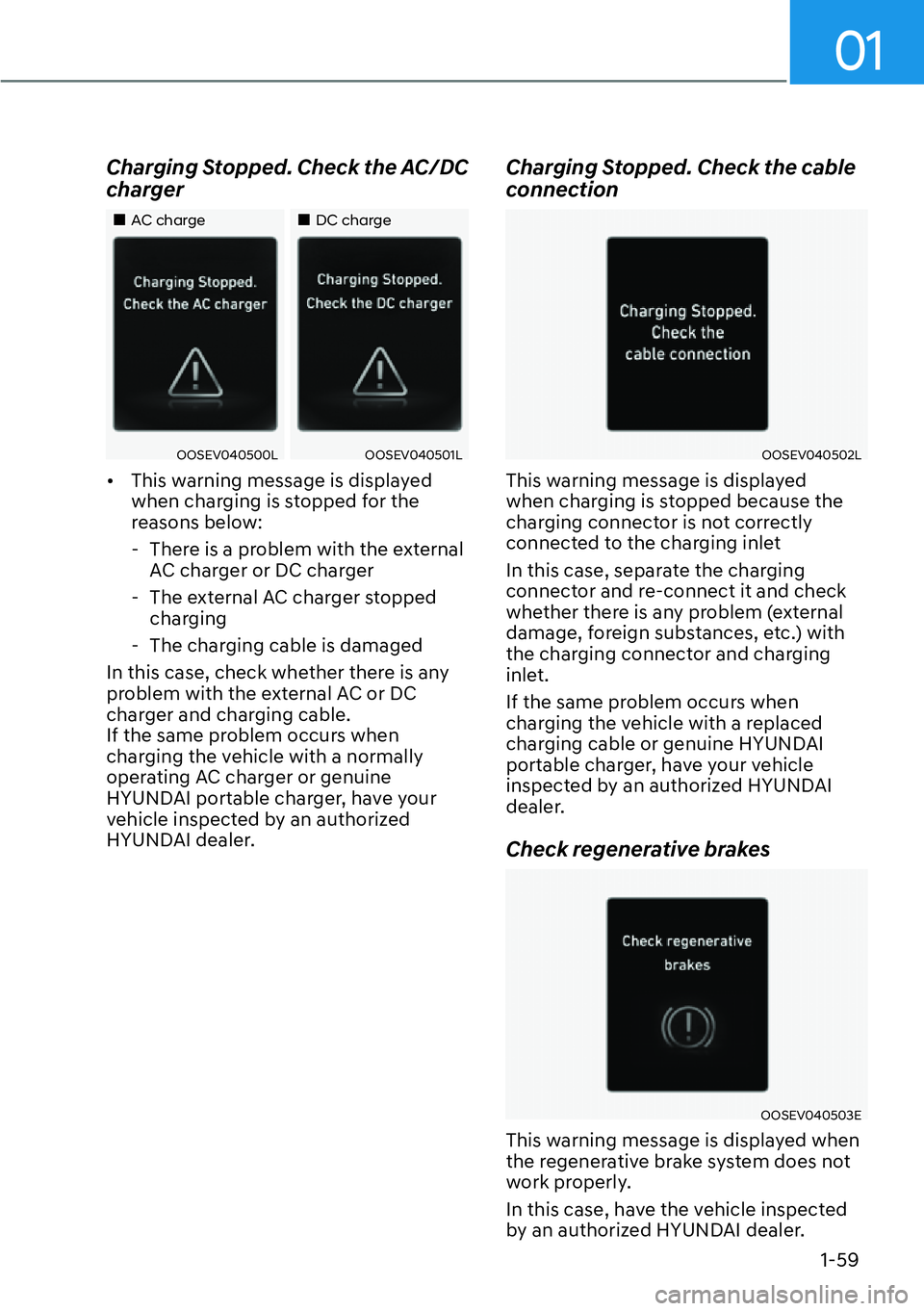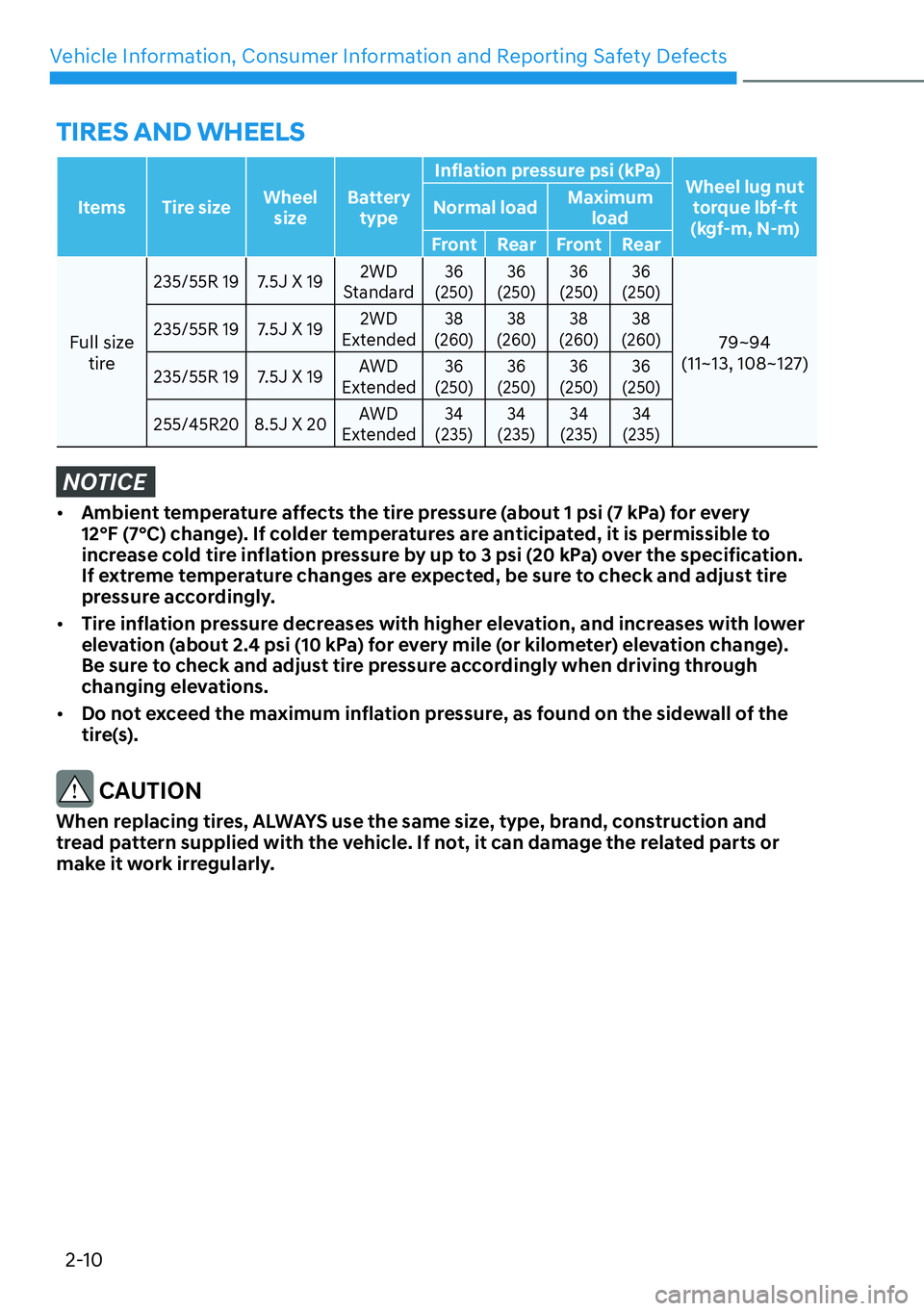Page 55 of 663

Foreword / Starting your Electric vehicle
1-50
DRIVING ELECTRIC VEHICLE
How to Start the Vehicle
1. Holding the smart key, sit in the
driver’s seat.
2. Fasten the seat belt before starting
the vehicle.
3. Make sure to engage the parking
brake.
4. Turn OFF all electrical devices.
5. Make sure to depress and hold the
brake pedal.
6. While depressing the brake pedal,
shift to P (Park).
7. Depress and hold the brake pedal
while pressing the Start/Stop button.
ONE1Q011047
8. When the “” indicator is ON,
you can drive the vehicle.
When the “
” indicator is OFF,
you cannot drive the vehicle. Start the
vehicle again.
9. Depress and hold the brake pedal and
shift to the desired position.
Information
While the charging cable is connected, the
gear cannot be shift from P (Park) to any
other gear for safety reasons.10. Release the parking brake and slowly
release the brake pedal. Check if the
vehicle slowly moves forward, then
depress the accelerator pedal.
How to Stop the Vehicle
1. Hold down the brake pedal while the
vehicle is parked.
2. While depressing the brake pedal,
shift to P (Park).
3. While depressing the brake pedal,
engage the parking brake.
4. While depressing the brake pedal,
press the Start/Stop button and turn
off the vehicle.
ONE1Q011048
5. Check if the “” indicator is
turned OFF on the instrument cluster.
When the “
” indicator is ON
and the gear is in a position other than
P (Park), the driver can accidently
depress the accelerator pedal, causing
the vehicle to move unexpectedly.
Page 56 of 663

01
1-51
Virtual Engine Sound System
The Virtual Engine Sound System
generates engine sound for pedestrians
to hear vehicle sound because there is
no sound while the Electric Vehicle (EV)
is operating.
�[��If the vehicle is in the ready (
)
mode and the gear is not in P (Park),
the VESS will be operated.
�[��When the gear is shifted to R
(Reverse), an additional warning
sound will be heard.
CAUTION
�[��The vehicle is much quieter while
driving than a conventional gasoline-
powered vehicle. Be aware of your
surroundings and always drive safely.
�[��After you park the vehicle or while
you are waiting at a traffic light,
check whether there are children or
obstacles around the vehicle.
�[��Check if there is something behind
the vehicle when driving in reverse.
Pedestrians may not hear the sound
of the vehicle.
Distance to Empty
ONE1Q011099N
The distance to empty is displayed
differently according to the selected
drive mode in the Drive Mode Integrated
Control System.
For more information, refer to “Drive
Mode Integrated Control System” in
chapter 6.
When destination is not set
�[��On average, a vehicle can drive about
200 miles (320 km) (Standard type) /
300 miles (400 km) (Extended type).
�[��Under certain circumstances where
the air conditioner/heater is ON,
the distance to empty is impacted,
resulting in a possible distance range
from 106 ~ 286 miles (170 ~ 460 km)
(Standard type) / 130 ~ 300 miles
(210 ~ 570 km) (Extended type).
When using the heater during cold
weather or driving at high speed, the
high voltage battery consumes a lot
more electricity. This may reduce the
distance to empty significantly.
�[��After ‘0 km’ has been displayed,
the vehicle can drive an additional
2~5 miles (3~8 km) depending on
driving speed, heater/air conditioner,
weather, driving style, and other
factors.
Page 58 of 663
01
1-53
ECO Driving
ONE1Q011034E
In order to check the ECO driving history,
�V�H�O�H�F�W���S�0�H�Q�X���
Page 59 of 663

Foreword / Starting your Electric vehicle
1-54
3. ‘Electronics’ shows the power and
energy consumption which are used
by the vehicle systems including the
cluster, infotainment system(speaker
and navigation), headlamp, vehicle
control unit, etc.
4. ‘Driving’ shows the total power
and energy consumption of the
driving motor’s driving energy and
regenerative energy.
Power/Charge Gauge
ONE1Q011050
The Power/Charge Gauge shows the
energy consumption rate of the vehicle
and the charge/discharge status of the
regenerative brakes.
�[��POWER :
It shows the energy consumption rate
of the vehicle when driving uphill or
accelerating. The more electric energy
is used, the higher the gauge level.
�[��CHARGE :
It shows the charging status of the
battery when it is being charged by
the regenerative brakes (decelerating
or driving on a downhill road). The
more electric energy is charged, the
lower the gauge level.
State Of Charge (SOC) Gauge for
High Voltage Battery
ONE1Q011003
�[��The SOC gauge shows the charging
status of the high voltage battery.
�[��The low percentage number on the
indicator indicates that there is not
enough energy in the high voltage
battery. 100 % indicates that the
driving battery is fully charged.
�[��When driving on highways or
motorways, make sure to check
in advance if the driving battery is
charged enough.
Page 64 of 663

01
1-59
Charging Stopped. Check the AC/DC
charger
���„AC charge���„DC charge
OOSEV040500LOOSEV040501L
�[��This warning message is displayed
when charging is stopped for the
reasons below:
- There is a problem with the external
AC charger or DC charger
- The external AC charger stopped
charging
- The charging cable is damaged
In this case, check whether there is any
problem with the external AC or DC
charger and charging cable.
If the same problem occurs when
charging the vehicle with a normally
operating AC charger or genuine
HYUNDAI portable charger, have your
vehicle inspected by an authorized
HYUNDAI dealer.
Charging Stopped. Check the cable
connection
OOSEV040502L
This warning message is displayed
when charging is stopped because the
charging connector is not correctly
connected to the charging inlet
In this case, separate the charging
connector and re-connect it and check
whether there is any problem (external
damage, foreign substances, etc.) with
the charging connector and charging
inlet.
If the same problem occurs when
charging the vehicle with a replaced
charging cable or genuine HYUNDAI
portable charger, have your vehicle
inspected by an authorized HYUNDAI
dealer.
Check regenerative brakes
OOSEV040503E
This warning message is displayed when
the regenerative brake system does not
work properly.
In this case, have the vehicle inspected
by an authorized HYUNDAI dealer.
Page 67 of 663
Foreword / Starting your Electric vehicle
1-62
Stop vehicle and check power
supply
OOSEV040511L
This warning message is displayed when
a failure occurs in the power supply
system.
In this case, park the vehicle in a safe
location and tow your vehicle to the
nearest authorized HYUNDAI dealer and
have the vehicle inspected.
Check virtual engine sound system
OOSEV040512L
This message is displayed when there is
a problem with the Virtual Engine Sound
System (VESS).
In this case, have the vehicle inspected
by an authorized HYUNDAI dealer.
Check electric vehicle system
OOSEV040513L
This warning message is displayed when
there is a problem with the electric
vehicle control system.
Refrain from driving when the warning
message is displayed.
In this case, have the vehicle inspected
by an authorized HYUNDAI dealer.
Page 80 of 663

Vehicle Information, Consumer Information and Reporting Safety Defects
2-10
Items Tire sizeWheel
sizeBattery
typeInflation pressure psi (kPa)
Wheel lug nut
torque lbf-ft
(kgf-m, N-m) Normal loadMaximum
load
Front Rear Front Rear
Full size
tire
235/55R 19 7.5J X 192WD
Standard36
(250)36
(250)36
(250)36
(250)
79~94
(11~13, 108~127)235/55R 19 7.5J X 192WD
Extended38
(260)38
(260)38
(260)38
(260)
235/55R 19 7.5J X 19AWD
Extended36
(250)36
(250)36
(250)36
(250)
255/45R20 8.5J X 20AWD
Extended34
(235)34
(235)34
(235)34
(235)
NOTICE
�[��Ambient temperature affects the tire pressure (about 1 psi (7 kPa) for every
12°F (7°C) change). If colder temperatures are anticipated, it is permissible to
increase cold tire inflation pressure by up to 3 psi (20 kPa) over the specification.
If extreme temperature changes are expected, be sure to check and adjust tire
pressure accordingly.
�[��Tire inflation pressure decreases with higher elevation, and increases with lower
elevation (about 2.4 psi (10 kPa) for every mile (or kilometer) elevation change).
Be sure to check and adjust tire pressure accordingly when driving through
changing elevations.
�[��Do not exceed the maximum inflation pressure, as found on the sidewall of the
tire(s).
CAUTION
When replacing tires, ALWAYS use the same size, type, brand, construction and
tread pattern supplied with the vehicle. If not, it can damage the related parts or
make it work irregularly.
TIRES AND WHEELS
Page 83 of 663
02
2-13
VEHICLE IDENTIFICATION
�1�8�0�%�(�5���ã�9�,�1�ä
���„Frame number
ONE1011020N
The vehicle identification number (VIN)
is the number used in registering your
vehicle and in all legal matters pertaining
to its ownership, etc.
The number is punched on the floor
under the right front seat. To check the
number, open the cover.
���„VIN label (if equipped)
ONE1011021
The VIN is also on a plate attached to
the top of the left side dashboard. The
number on the plate can easily be seen
through the windshield from outside.
VEHICLE CERTIFICATION
LABEL
ONE1011022
The vehicle certification label attached
on the driver’s (or front passenger’s)
side center pillar gives the vehicle
identification number (VIN).